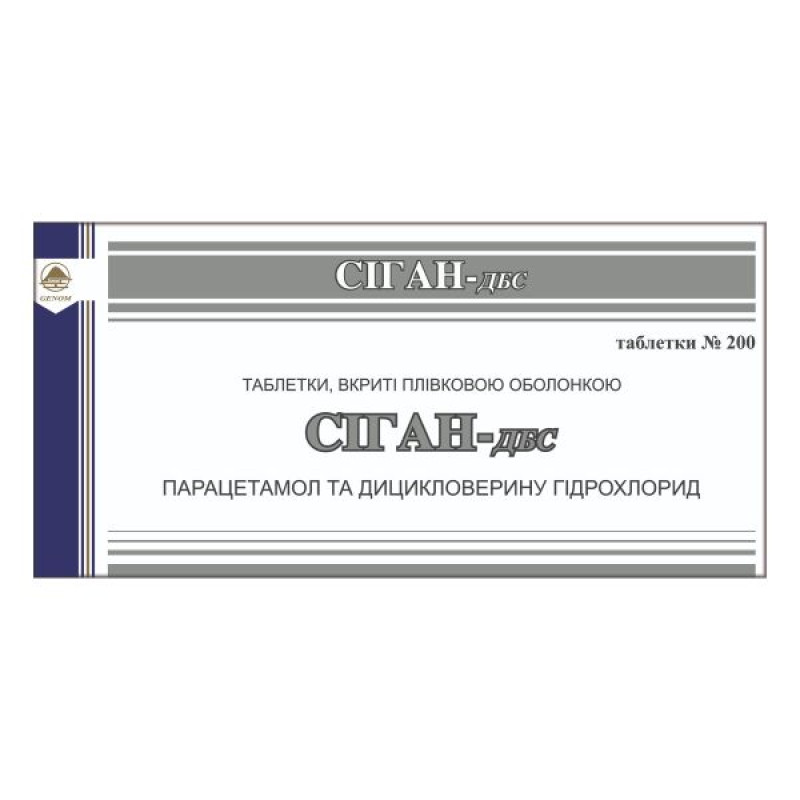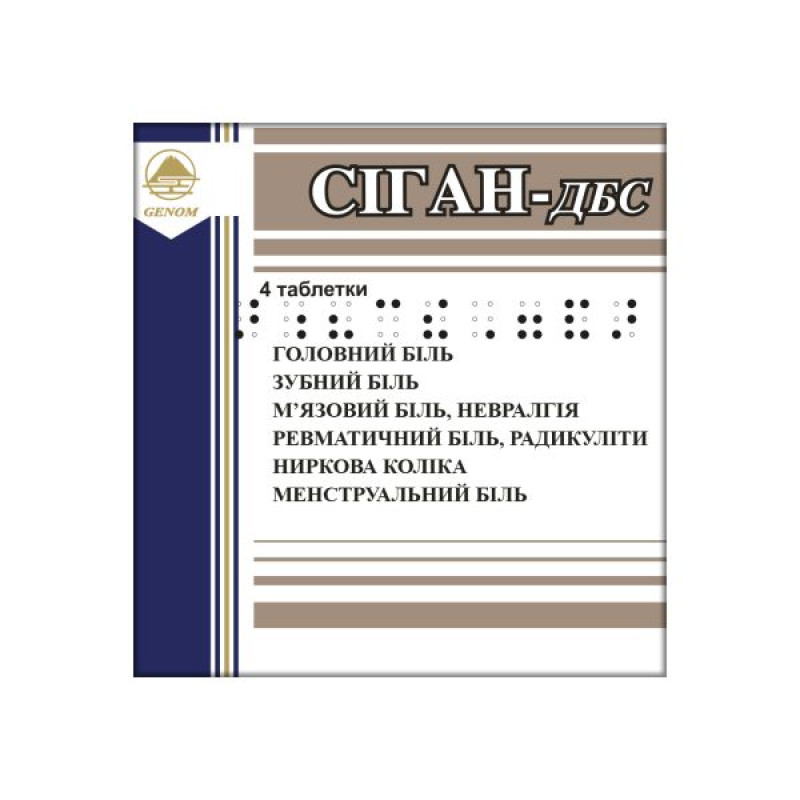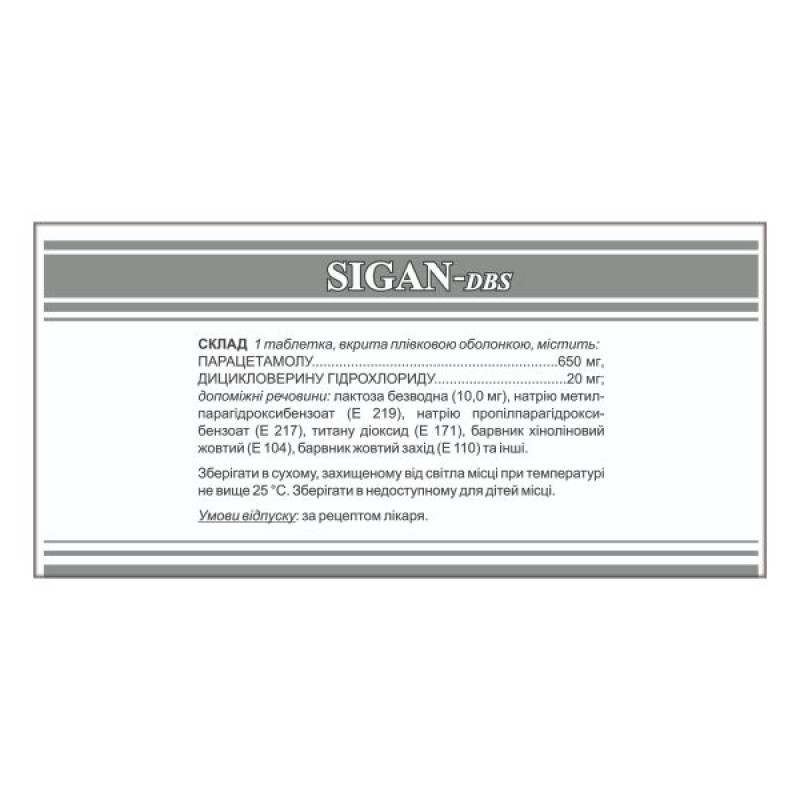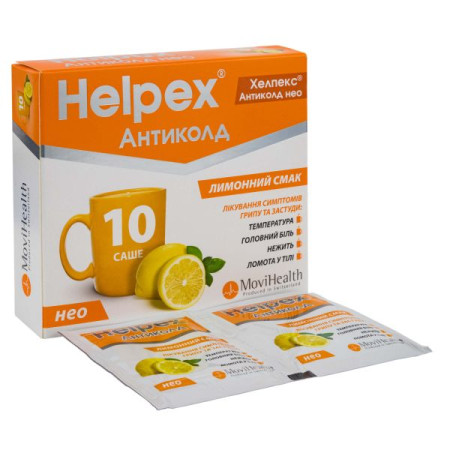Sigan-DBS film-coated tablets No. 200
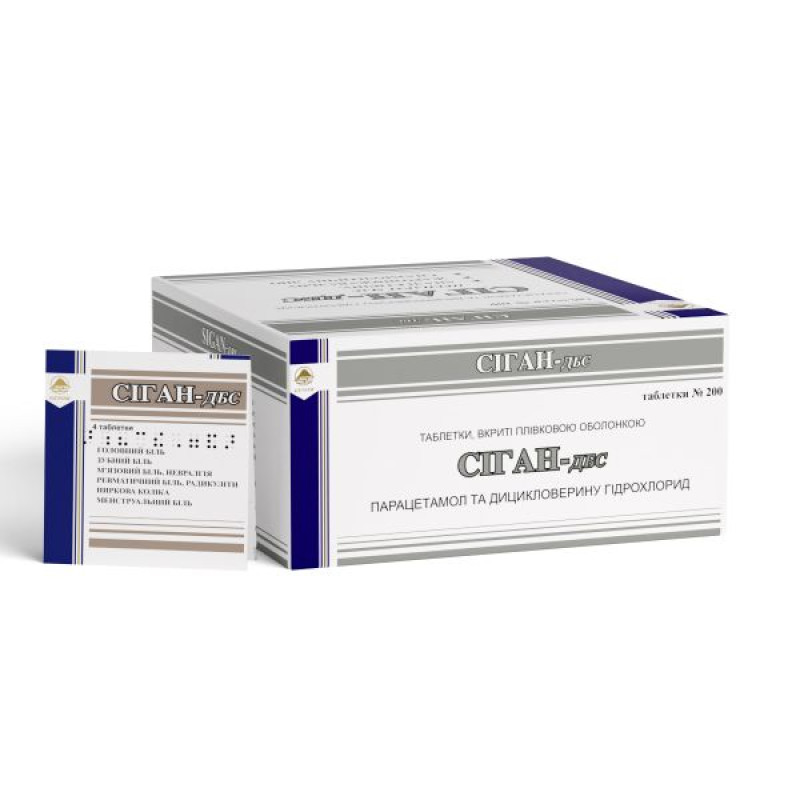
Instructions for use of Sigan-DBS film-coated tablets No. 200
Composition
active ingredients: 1 tablet contains paracetamol 650 mg, dicycloverine hydrochloride 20 mg;
excipients: microcrystalline cellulose, anhydrous lactose (10 mg), corn starch, povidone, sodium methyl parahydroxybenzoate (E 219), sodium propyl parahydroxybenzoate (E 217), magnesium stearate, sodium starch glycolate;
film coating: hypromellose, macrogol 400, titanium dioxide (E 171), talc, quinoline yellow dye (E 104), sunset yellow dye (E 110).
Dosage form
Film-coated tablets.
Main physicochemical properties: tablets, film-coated, orange, round, biconvex, smooth on both sides.
Pharmacotherapeutic group
Analgesics and antipyretics. Paracetamol, combinations without psycholeptics.
ATX code N02B E51.
Pharmacological properties
Pharmacodynamics.
A combined drug that has analgesic and antispasmodic effects.
Paracetamol acts as an analgesic and antipyretic. The analgesic and antipyretic effects of paracetamol (a non-opiate, non-salicylate analgesic) are associated with the drug's effect on the thermoregulatory center in the hypothalamus and its ability to inhibit prostaglandin synthesis.
Dicyclomine hydrochloride is a tertiary amine. It has anticholinergic activity and reduces smooth muscle tone, eliminates pain, blocks antagonistic activity. Dicyclomine hydrochloride selectively paralyzes M-cholinergic structures, blocking the transmission of impulses from postganglionic cholinergic nerves to the effector organs innervated by them. Causes relaxation of smooth muscles, exhibiting an antispasmodic effect in spasms of smooth muscles of the stomach, intestines, biliary tract, urogenital and vascular systems.
Pharmacokinetics.
Paracetamol is rapidly and almost completely absorbed from the gastrointestinal tract; it is rapidly distributed in body fluids and weakly binds to plasma proteins. The maximum concentration in plasma is reached after 20–30 minutes.
Paracetamol crosses the placental barrier. A small amount of it penetrates into breast milk. Approximately 85% of paracetamol is metabolized in the liver by sulfo- and glucuronic conjugation, 15% is metabolized by oxidation by cytochrome P450.
The half-life is approximately 3 hours. Excreted in the urine as metabolites. In cases of hepatic insufficiency, the metabolism of paracetamol is not altered.
After oral administration, dicyclomine is rapidly absorbed, with peak plasma concentrations occurring approximately 1.5 hours later. The elimination half-life is 4–6 hours. It is excreted in the urine (79.5%) and feces (8.4%).
Indication
Pain syndromes with a spastic component of various origins:
headache;
toothache;
muscle pain, neuralgia;
rheumatic pain, radiculitis;
renal colic;
menstrual pain.
Contraindication
Hypersensitivity to the components of the drug. Obstructive diseases of the gastrointestinal tract, urinary and biliary tract with impaired conductivity. Peptic ulcer of the stomach or duodenum, reflux esophagitis, acute bleeding. Glaucoma, myasthenia gravis, thyrotoxicosis, heart failure. Prostate adenoma. Dynamic intestinal obstruction, paralytic intestinal obstruction, pyloric stenosis of the gastrointestinal tract with obstruction, severe ulcerative colitis. Hepatic and renal failure, congenital hyperbilirubinemia (Gilbert syndrome, Dubin-Johnson syndrome and Rotor syndrome), glucose-6-phosphate dehydrogenase deficiency, severe anemia, including hemolytic anemia, and leukopenia. Alcoholism.
Interaction with other medicinal products and other types of interactions
The specifics of the interaction of a medicinal product are determined by the properties of its components.
Paracetamol, which is part of the drug Sigan-DBS, reduces the effectiveness of diuretics.
The simultaneous use of paracetamol with barbiturates, diphenyl, carbamazepine, rifampicin and other inducers of microsomal liver enzymes, as well as anticonvulsants increases the risk of hepatotoxic reactions, and the use of high doses of paracetamol with isoniazid increases the risk of hepatotoxic syndrome.
Barbiturates reduce the antipyretic effect. The rate of absorption of paracetamol may increase when used together with metoclopramide and domperidone and decrease when used together with cholestyramine.
The effect of paracetamol is enhanced when combined with codeine, ascorbic acid, scopolamine, chlorphenamine, propyphenazone, and caffeine.
Concomitant use of paracetamol with azidothymidine may lead to neutropenia. The anticoagulant effect of warfarin and other coumarins is enhanced by long-term regular use of paracetamol, with an increased risk of bleeding. Intermittent use does not have this effect.
Concomitant use of paracetamol with nonsteroidal anti-inflammatory drugs increases the risk of kidney complications.
The effect of dicycloverine hydrochloride is enhanced by amantadine, antipsychotic agents, benzodiazepines, monoamine oxidase inhibitors (MAOIs), narcotic analgesics (e.g. meperidine), nitrates and nitrites, sympathomimetics, tricyclic antidepressants, anticholinergics, and corticosteroids.
Dicyclomine hydrochloride enhances the effect of digoxin and other anticholinergics (e.g. atropine sulfate), so it is inappropriate to prescribe them simultaneously with the drug Sigan-DBS. The simultaneous use of dicyclomine with other anticholinergics is not recommended. The drug enhances the effect of salicylic acid, pyrazolone, codeine, caffeine. Potentiates the effect of antispasmodics.
Anticholinergic drugs may neutralize the effect of antiglaucoma drugs, so the drug should be prescribed with caution in cases of increased intraocular pressure and concomitant use of corticosteroids.
Since antacids may reduce the absorption of anticholinergic drugs, their concomitant use should be avoided.
The inhibitory effect of anticholinergic agents on the secretion of hydrochloric acid in the stomach can be neutralized by drugs used to treat achlorhydria and study gastric secretion.
Do not use simultaneously with alcohol (ethanol).
Application features
Due to the fact that the medicinal product contains paracetamol, monitoring of peripheral blood counts and liver function is required during use.
Cannot be used simultaneously with other drugs that also contain paracetamol due to the possibility of overdose symptoms.
Do not exceed the indicated doses.
If the symptoms of the disease do not disappear, you should consult a doctor.
Patients who regularly take analgesics for mild arthritis should consult a doctor before using the drug.
Use of the drug for more than 3 days requires mandatory medical supervision.
If you develop a persistent headache, you should consult a doctor.
The risk of hepatotoxic effects of paracetamol is increased in patients with alcoholic liver disease and in individuals who abuse alcohol.
Use with caution in urinary retention, prostatic hyperplasia without urinary retention, heart failure, ulcerative colitis, impaired renal and hepatic function. May exacerbate gastroesophageal reflux.
The drug should be prescribed with caution to patients with autonomic neuropathy, arterial hypertension, ischemic heart disease with tachyarrhythmias, tachycardia, a tendency to bronchospasm, as well as with increased individual sensitivity to nonsteroidal anti-inflammatory drugs.
It should be noted that patients taking anticholinergic drugs, including dicyclomine hydrochloride, may experience psychosis, confusion, disorientation, ataxia, increased fatigue, or vice versa - euphoria, agitation, insomnia, affective state. These symptoms usually disappear within 12-24 hours after discontinuation of the drug.
The drug may affect the results of laboratory tests for blood glucose and uric acid.
At high ambient temperatures, dicycloverine hydrochloride, by reducing sweating, causes an increase in body temperature with the risk of heat stroke. If appropriate symptoms appear, you should stop taking the drug and consult a doctor.
When prescribing the drug Sigan-DBS to elderly people, dosage adjustment is not required.
Sigan-DBS contains lactose, therefore patients with rare hereditary forms of galactose intolerance, lactase deficiency or glucose-galactose malabsorption syndrome should not use it.
Before using the drug, it is necessary to consult a doctor if the patient is using warfarin or similar drugs that have an anticoagulant effect.
Use during pregnancy or breastfeeding
The medicine is not recommended for women during pregnancy or breastfeeding.
Ability to influence reaction speed when driving vehicles or other mechanisms
Dicyclomine hydrochloride may cause adverse reactions from the nervous system and visual organs; when using the drug, you should refrain from driving or operating other mechanisms.
Method of administration and doses
Sigan-DBS should be taken orally, washed down with a small amount of liquid (200 ml).
Adults: 1–2 tablets depending on the severity of the pain 1–4 times a day. When treating adults, it is advisable to start with 4 tablets per day. The maximum dose can be increased to 8 tablets per day, provided that it is well tolerated and there are no side effects.
The duration of treatment should be determined individually, depending on the patient's condition and response. If the effectiveness of treatment is not achieved within 2 weeks or there are signs of side effects at a dose of less than 4 tablets per day, the drug should be discontinued.
Children aged 13 to 15 years: 1 tablet 1–3 times a day; aged 15 years and over: 1–2 tablets depending on the severity of the pain 1–4 times a day.
The duration of treatment is determined by the doctor individually depending on the nature and course of the disease.
Children.
The drug should not be prescribed to children under 13 years of age.
Overdose
The risk of paracetamol overdose is higher in patients with non-cirrhotic alcoholic liver disease. Symptoms of overdose in the first 24 hours: pale skin. Anorexia, nausea, vomiting, abdominal pain. In case of significant overdose - hepatonecrosis.
Symptoms of liver damage are observed 12–48 hours after an overdose.
Glucose metabolism disorders and metabolic acidosis may occur. In severe poisoning, hepatic failure may progress to toxic encephalopathy. Acute renal failure with acute tubular necrosis may develop even in the absence of severe renal damage. Cardiac arrhythmias have also been reported.
In patients with risk factors [long-term treatment with carbamazepine, phenobarbital, phenytoin, primidone, rifampicin, St. John's wort or other drugs that induce liver enzymes; regular use of excessive amounts of ethanol; glutathione cathexis (digestive disorders, cystic fibrosis, HIV infection, starvation, cachexia)], the use of 5 g or more of paracetamol may lead to liver damage.
Liver damage is possible in adults who have taken 10 g or more of paracetamol, and in children who have taken more than 150 mcg/kg of body weight.
In severe poisoning, hepatic failure may progress to encephalopathy, hemorrhage, hypoglycemia, coma, and death. Acute renal failure with acute tubular necrosis may present with severe lumbar pain, hematuria, and proteinuria and may develop even in the absence of severe liver damage.
Pancreatitis was noted.
With prolonged use of the drug in high doses, aplastic anemia, pancytopenia, agranulocytosis, neutropenia, leukopenia, thrombocytopenia may develop from the hematopoietic system. When taking high doses, dizziness, psychomotor agitation and disorientation are possible from the central nervous system (CNS); nephrotoxicity (renal colic, interstitial nephritis, capillary necrosis) is possible from the urinary system.
In case of overdose, urgent medical attention is required. The patient should be taken to hospital immediately, even if there are no early symptoms of overdose. Symptoms may be limited to nausea and vomiting or may not reflect the severity of the overdose or the risk of organ damage. Treatment with activated charcoal should be considered if the overdose of paracetamol has been taken within 1 hour. The concentration of paracetamol in the blood plasma should be measured 4 hours or later after ingestion (earlier concentrations are unreliable). Treatment with N-acetylcysteine can be used within 24 hours of paracetamol ingestion, but the maximum protective effect occurs when it is used within 8 hours of ingestion. The effectiveness of the antidote decreases sharply after this time. If necessary, the patient should be given N-acetylcysteine intravenously, according to current recommendations. In the absence of vomiting, oral methionine can be used as a suitable alternative in remote areas outside the hospital.
Caused by dicycloverine hydrochloride
Overdose is characterized by a two-phase nature: first, central nervous system excitation occurs, which is manifested by restlessness, the appearance of illusions, hallucinations, persistent mydriasis, tachycardia, and arterial hypertension. Then, central nervous system depression occurs, up to a comatose state.
In the first 24 hours – pale skin, nausea, anorexia, vomiting and abdominal pain; after 12–48 hours – kidney and liver damage with the development of liver failure (increased activity of hepatic transaminases, dehydrogenase, increased concentration of bilirubin, prothrombin); tachycardia, arrhythmias; change in respiratory rate; pancreatitis.
Dry skin and mucous membranes, increased intraocular pressure, headache, dizziness, central nervous system excitation, urinary retention.
Treatment: gastric lavage, use adsorbents, orally – methionine (accelerates the conjugation reaction of paracetamol). Paracetamol antidote (stimulates glutathione synthesis) – acetylcysteine (10% solution, 5 ml). Symptomatic therapy is indicated. To relieve psychomotor agitation – diazepam (0.5% solution, 2 ml).
Adverse reactions
Sigan-DBS is generally well tolerated. Side effects associated with the active ingredients of the drug usually occur with prolonged use in high doses.
Paracetamol.
On the part of the digestive tract: nausea, epigastric pain, increased activity of liver enzymes, usually without the development of jaundice, hepatonecrosis (dose-dependent effect), digestive disorders.
From the blood and lymphatic system: anemia, methemoglobinemia, thrombocytopenia, sulfhemoglobinemia (cyanosis, shortness of breath, heart pain), hemolytic anemia (especially for patients with glucose-6-phosphate dehydrogenase deficiency). With prolonged use in high doses - aplastic anemia, pancytopenia, agranulocytosis, neutropenia, leukopenia.
On the part of the immune system: anaphylaxis, hypersensitivity reactions, including skin itching, rash on the skin and mucous membranes (usually generalized rash, erythematous rash, urticaria), angioedema, erythema multiforme exudative (including Stevens-Johnson syndrome), toxic epidermal necrolysis (Lyell's syndrome), hypoglycemia, up to hypoglycemic coma; bronchospasm in patients sensitive to aspirin and other nonsteroidal anti-inflammatory drugs (NSAIDs); impaired liver function, increased activity of liver enzymes, usually without the development of jaundice.
From the side of the central nervous system (usually when taking high doses): dizziness, psychomotor agitation and disorientation.
Others: hypoglycemia, tinnitus, psychosis, coma, general weakness, bruising or bleeding.
Dicycloverine hydrochloride.
Skin and subcutaneous tissue disorders: rash, pruritus, urticaria, severe allergic reactions or drug idiosyncrasy, including anaphylaxis.
On the part of the digestive tract: dry mouth, taste disturbance, anorexia, nausea, vomiting, flatulence, constipation, abdominal pain, digestive disorders.
On the part of the organs of vision: blurred vision, diplopia, mydriasis, cycloplegia of vision (paralysis of accommodation), increased intraocular pressure.
From the side of the central nervous system and psyche: dizziness, sensory disturbances, headache, drowsiness, nervousness, tinnitus, psychosis, coma, dyskinesia, lethargy, insomnia, general weakness, fatigue, loss of consciousness, numbness, disorientation, short-term memory loss, hallucinations, dysarthria, ataxia, euphoria, inadequate emotional reactions (symptoms decrease 12–24 hours after dose reduction), speech disorders, confusion and/or agitation.
Cardiovascular system: tachycardia, palpitations.
Urinary system disorders: urinary incontinence, urinary retention, difficulty urinating.
Musculoskeletal and connective tissue disorders: muscle weakness.
On the part of the respiratory system and chest organs: dyspnea, apnea, asphyxia, nasal congestion, sneezing, throat hyperemia.
Others: hot flashes, decreased sweating.
Expiration date
3 years.
Storage conditions
Store in the original packaging at a temperature not exceeding 25 ºС, out of the reach of children.
Packaging
No. 200: 4 tablets in a strip; 1 strip in a cardboard envelope; 50 envelopes in a cardboard box.
No. 4: 4 tablets in a strip; 1 strip in a cardboard envelope.
Vacation category
According to the recipe.
Producer
Genom Biotech Pvt. Ltd.
Location of the manufacturer and its business address
Plot No. D-121, 122, 123, M.I.D.C. Malegaon, Tal. Sinnar, Nashik 422103, Maharashtra, India.
There are no reviews for this product.
There are no reviews for this product, be the first to leave your review.
No questions about this product, be the first and ask your question.





